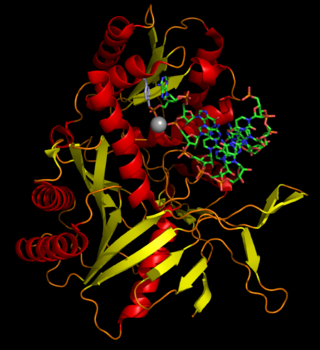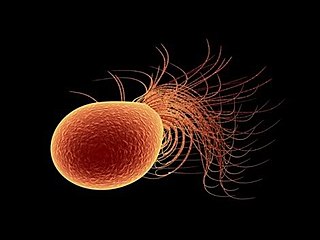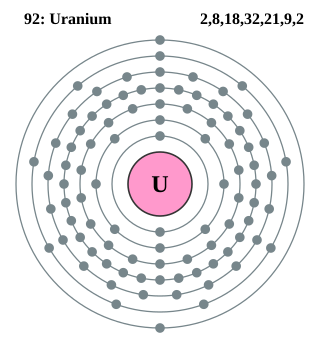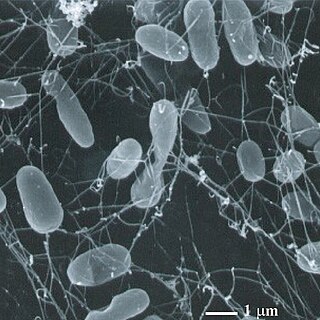Related Research Articles

An extremophile is an organism that is able to live in extreme environments, i.e. environments with conditions approaching or expanding the limits of what known life can adapt to, such as extreme temperature, radiation, salinity, or pH level.

A microorganism, or microbe, is an organism of microscopic size, which may exist in its single-celled form or as a colony of cells.
A hyperthermophile is an organism that thrives in extremely hot environments—from 60 °C (140 °F) upwards. An optimal temperature for the existence of hyperthermophiles is often above 80 °C (176 °F). Hyperthermophiles are often within the domain Archaea, although some bacteria are also able to tolerate extreme temperatures. Some of these bacteria are able to live at temperatures greater than 100 °C, deep in the ocean where high pressures increase the boiling point of water. Many hyperthermophiles are also able to withstand other environmental extremes, such as high acidity or high radiation levels. Hyperthermophiles are a subset of extremophiles. Their existence may support the possibility of extraterrestrial life, showing that life can thrive in environmental extremes.
Methanogens are microorganisms that produce methane as a metabolic byproduct in hypoxic conditions. They are prokaryotic and belong to the domain Archaea. All known methanogens are members of the archaeal phylum Euryarchaeota. Methanogens are common in wetlands, where they are responsible for marsh gas, and in the digestive tracts of animals such as ruminants and many humans, where they are responsible for the methane content of belching in ruminants and flatulence in humans. In marine sediments, the biological production of methane, also termed methanogenesis, is generally confined to where sulfates are depleted, below the top layers. Moreover, methanogenic archaea populations play an indispensable role in anaerobic wastewater treatments. Others are extremophiles, found in environments such as hot springs and submarine hydrothermal vents as well as in the "solid" rock of Earth's crust, kilometers below the surface.
Biological augmentation is the addition of archaea or bacterial cultures required to speed up the rate of degradation of a contaminant. Organisms that originate from contaminated areas may already be able to break down waste, but perhaps inefficiently and slowly.

Archaeoglobaceae are a family of the Archaeoglobales. All known genera within the Archaeoglobaceae are hyperthermophilic and can be found near undersea hydrothermal vents. Archaeoglobaceae are the only family in the order Archaeoglobales, which is the only order in the class Archaeoglobi.
Archaeoglobus is a genus of the phylum Euryarchaeota. Archaeoglobus can be found in high-temperature oil fields where they may contribute to oil field souring.
Methanopyrus is a genus of the Methanopyraceae.

A thermoacidophile is an extremophilic microorganism that is both thermophilic and acidophilic; i.e., it can grow under conditions of high temperature and low pH. The large majority of thermoacidophiles are archaea or bacteria, though occasional eukaryotic examples have been reported. Thermoacidophiles can be found in hot springs and solfataric environments, within deep sea vents, or in other environments of geothermal activity. They also occur in polluted environments, such as in acid mine drainage.

Pyrococcus furiosus is a heterotrophic, strictly anaerobic, extremophilic, model species of archaea. It is classified as a hyperthermophile because it thrives best under extremely high temperatures, and is notable for having an optimum growth temperature of 100 °C. P. furiosus belongs to the Pyrococcus genus, most commonly found in extreme environmental conditions of hydrothermal vents. It is one of the few prokaryotic organisms that has enzymes containing tungsten, an element rarely found in biological molecules.
Microbial metabolism is the means by which a microbe obtains the energy and nutrients it needs to live and reproduce. Microbes use many different types of metabolic strategies and species can often be differentiated from each other based on metabolic characteristics. The specific metabolic properties of a microbe are the major factors in determining that microbe's ecological niche, and often allow for that microbe to be useful in industrial processes or responsible for biogeochemical cycles.
Microbial genetics is a subject area within microbiology and genetic engineering. Microbial genetics studies microorganisms for different purposes. The microorganisms that are observed are bacteria, and archaea. Some fungi and protozoa are also subjects used to study in this field. The studies of microorganisms involve studies of genotype and expression system. Genotypes are the inherited compositions of an organism. Genetic Engineering is a field of work and study within microbial genetics. The usage of recombinant DNA technology is a process of this work. The process involves creating recombinant DNA molecules through manipulating a DNA sequence. That DNA created is then in contact with a host organism. Cloning is also an example of genetic engineering.

Biomining is the technique of extracting metals from ores and other solid materials typically using prokaryotes, fungi or plants. These organisms secrete different organic compounds that chelate metals from the environment and bring it back to the cell where they are typically used to coordinate electrons. It was discovered in the mid 1900s that microorganisms use metals in the cell. Some microbes can use stable metals such as iron, copper, zinc, and gold as well as unstable atoms such as uranium and thorium. Large chemostats of microbes can be grown to leach metals from their media. These vats of culture can then be transformed into many marketable metal compounds. Biomining is an environmentally friendly technique compared to typical mining. Mining releases many pollutants while the only chemicals released from biomining is any metabolites or gasses that the bacteria secrete. The same concept can be used for bioremediation models. Bacteria can be inoculated into environments contaminated with metals, oils, or other toxic compounds. The bacteria can clean the environment by absorbing these toxic compounds to create energy in the cell. Bacteria can mine for metals, clean oil spills, purify gold, and use radioactive elements for energy.
In taxonomy, Staphylothermus is a genus of the Desulfurococcaceae.[1]

Pyrolobus fumarii is a species of archaea known for its live and reproduction at extremely high temperatures that kill most organisms. P. fumarii is known as a hyperthermophile obligately chemolithoautotroph. In the simplest terms, this archaea grows best in warm temperatures ranging from 80 °C to 115 °C. It also uses preformed molecules as its energy source rather than light, inorganic as an electron donor, and CO2 is used as a carbon source. It was first discovered in 1997 in a black smoker hydrothermal vent at the Mid-Atlantic Ridge, setting the upper-temperature threshold for known life to exist at 113 °C (235.4 °F) with an optimal temperature of 106 °C. This species "freezes" or solidifies and ceases growth at temperatures of 90 °C (194 °F) and below.
Biodegradable additives are additives that enhance the biodegradation of polymers by allowing microorganisms to utilize the carbon within the polymer chain as a source of energy. Biodegradable additives attract microorganisms to the polymer through quorum sensing after biofilm creation on the plastic product. Additives are generally in masterbatch formation that use carrier resins such as polyethylene (PE), polypropylene (PP), polystyrene (PS) or polyethylene terephthalate (PET).
Petroleum microbiology is a branch of microbiology that deals with the study of microorganisms that can metabolize or alter crude or refined petroleum products. These microorganisms, also called hydrocarbonoclastic microorganisms, can degrade hydrocarbons and, include a wide distribution of bacteria, methanogenic archaea, and some fungi. Not all hydrocarbonoclasic microbes depend on hydrocarbons to survive, but instead may use petroleum products as alternative carbon and energy sources. Interest in this field is growing due to the increasing use of bioremediation of oil spills.

The root microbiome is the dynamic community of microorganisms associated with plant roots. Because they are rich in a variety of carbon compounds, plant roots provide unique environments for a diverse assemblage of soil microorganisms, including bacteria, fungi and archaea. The microbial communities inside the root and in the rhizosphere are distinct from each other, and from the microbial communities of bulk soil, although there is some overlap in species composition.
Bioremediation of petroleum contaminated environments is a process in which the biological pathways within microorganisms or plants are used to degrade or sequester toxic hydrocarbons, heavy metals, and other volatile organic compounds found within fossil fuels. Oil spills happen frequently at varying degrees along with all aspects of the petroleum supply chain, presenting a complex array of issues for both environmental and public health. While traditional cleanup methods such as chemical or manual containment and removal often result in rapid results, bioremediation is less labor-intensive, expensive, and averts chemical or mechanical damage. The efficiency and effectiveness of bioremediation efforts are based on maintaining ideal conditions, such as pH, RED-OX potential, temperature, moisture, oxygen abundance, nutrient availability, soil composition, and pollutant structure, for the desired organism or biological pathway to facilitate reactions. Three main types of bioremediation used for petroleum spills include microbial remediation, phytoremediation, and mycoremediation. Bioremediation has been implemented in various notable oil spills including the 1989 Exxon Valdez incident where the application of fertilizer on affected shoreline increased rates of biodegradation.

Extremophiles in biotechnology is the application of organisms that thrive in extreme environments to biotechnology.
References
- ↑ "Amazing Microbes". www.ornl.gov. Archived from the original on 2003-11-25.
- 1 2 Golyshina, Olga V. (17 June 2011). "Environmental, Biogeographic, and Biochemical Patterns of Archaea of the Family Ferroplasmaceae". Applied and Environmental Microbiology . 77 (15): 5071–5078. Bibcode:2011ApEnM..77.5071G. doi:10.1128/AEM.00726-11. PMC 3147448 . PMID 21685165 . Retrieved 22 May 2012.
- ↑ Elleuche, Skander, Carola Schro¨ Der, Kerstin Sahm, and Garabed Antranikian. "Extremozymes — Biocatalysts with Unique Properties from Extremophilic Microorganisms." Science Direct . Elsevier, 2014. Web.
- ↑ Adams, Michael W. W. "ENZYMES FROM MICROORGANISMS IN EXTREME ENVIRONMENTS." ENZYMES FROM MICROORGANISMS IN EXTREME ENVIRONMENTS - C&EN Global Enterprise (ACS Publications). N.p., n.d. Web. 14 Feb. 2017.